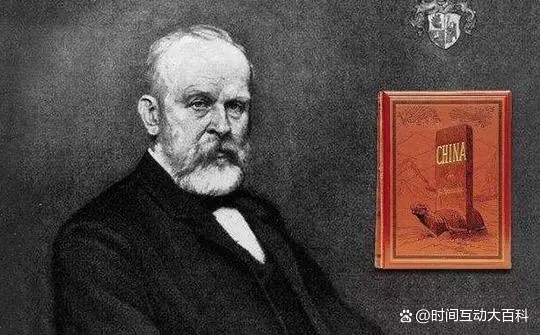发布时间: 2023-08-22

Not everyone is familiar with Ferdinand von Richthofen (1833-1905), but many more have heard of Sven Hedin (1865-1952), a more popular explorer and geographer who is known, among other things, for having discovered the Loulan Kingdom for the West. However, we must remember that Hedin was von Richthofen’s student. A German geographer and traveler, von Richthofen was a pioneer in modern geography, and his research on China was unprecedented in his time. He is noted for coining the term “Silk Road.” To this day, in the German language, China’s Qilian Mountains are still called the Richthofen Mountains.
Between 1868 and 1872, von Richthofen made seven geographical expeditions within China, covering 13 of the 18 provinces at that time. Upon his return to Germany, he wrote a five-volume masterpiece titled China: Ergebnisse eigner Reisen und darauf gegründeter Studien (English: China: The results of my travels and the studies based thereon). In the community of modern Chinese geology, von Richthofen has a significant position. In 1933, one of the earliest modern Chinese geologists, Weng Wenhao, wrote: “The solid foundation of Chinese geology was actually laid by the German von Richthofen. ...Thanks to his achievements in the field, we were saved decades of work.”
Von Richthofen died in 1905, and his Ferdinand von Richthofen’s Diaries from China was published posthumously in 1907 and eventually translated into Chinese and published by Commercial Press in 2018 as part of the series Chinese Translations of World Academic Classics. The two volumes of the work present von Richthofen’s itinerary in China, and the second volume includes passages about Jinhua. He entered inland from Tiantai, traveled via Pan’an to Dongyang, and then followed the river, going through Fotang, Jinhua, and Lanxi. Providing a detailed description of the landforms and customs observed along the way, he left a historic chapter about the Jinhua of the 1870s.
During the hottest season of the year, between June 12 and August 8, 1871, von Richthofen traveled around Zhejiang, Anhui, and Jiangsu. Upon leaving Ningbo, his first destination was Jinhua.
After leaving Ningbo and passing through Tiantai Mountain, names familiar to those living in Jinhua appear in his notes, which include a reference to the village of Matang. At this point, von Richthofen had already entered Pan’an—in fact, the village of Matang is located in the area of the Yushan Ancient Tea Plantation—and the diary describes in detail the tea-picking scene and explains that tea cultivation is a major activity in the area, where tea plantations are vast and the soil favorable. The family he stayed with on the hill was busy with tea picking.
As a 19th-century backpacker, von Richthofen wrote that if one wants to understand the mountains of Zhejiang, he strongly recommends his reader take the road he had traveled, claiming that the route he took to explore and learn about the land was the best one he had ever experienced. He would get up at 4 o’clock every day and march from 6 or 6:30 in the morning until between 5 and 7 in the evening. In between, he would only take a two-hour lunch break. He traveled with porters and brought what could be called luxurious table settings: eggs, flour, china and glass dishes, and even a beautiful colored blanket.
Although it was extremely hard to travel through the mountains, von Richthofen did not hesitate to praise this arduous and beautiful journey. In his notes, he stressed that never on any other routes had he gained such an insight into the landscape of this region. He commented that every time he would climb a mountain, he could enjoy there the joy of the view. (English text edited by Kendra Fiddler)
| 1 | 2 | > | >> |

